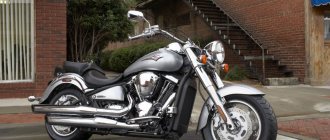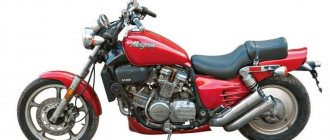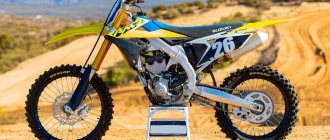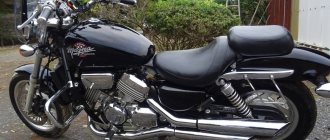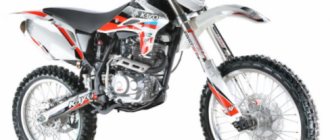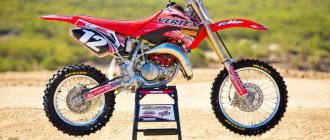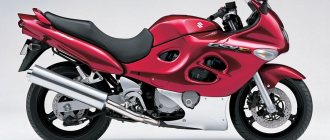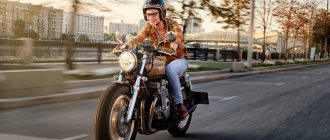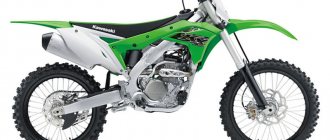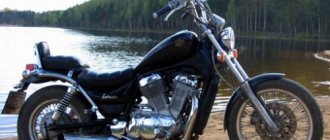Magna VF 750
- Honda motorcycle model
The Honda Magna 750 cruiser model appeared in 1982 as the “brother” of the Honda VF750S Saber model. The factory model designation is Honda VF750C. It became the first production cruiser with a V-shaped 4-cylinder engine from the Honda VFR750 sports tourer. The model was available in Japan, Europe and North America.
The first modifications of the Honda Magna 750 had the classic appearance of Japanese cruisers of that time - a short wheelbase, road fork offset, double disc brakes, cardan drive and hydraulic clutch.
Since 1987, the model has been seriously updated in appearance and receives the features of a power cruiser - a lower part, wide rear tires on a monolithic alloy wheel, expressive exhaust pipes, a stepped saddle and a front brake with a single disc. This generation has a maximum power of 77 hp. (Japanese versions), export modifications (North America, Great Britain) produced up to 88 hp.
Since 1993, the Magna model has undergone another major restyling. Getting a more modern appearance, it is also equipped with a chain drive (instead of a cardan), a cable clutch drive (instead of hydraulics), a new engine with a modified timing system, a 5-speed gearbox (previous versions - 5-speed + OD (overdrive), new wheels and carburetors with enlarged flaps.
2003 was the final year of production of the model, after which it left the assembly line and did not receive further development. However, throughout its production, the Magna 750 has won a huge army of fans around the world, who still prefer this particular model.
The “younger brother” of the model is the Honda Magna 250.
The model also has a name - Honda VF 750 Magna.
The main competitors of the Honda Magna 750 (V45) in the class:
Yamaha FZX 750
Brief history of the model
1982 - start of production and sales of the model. First generation. Model: Honda VF750 Magna (Europe, North America, Japan). Factory designation: VF750CC.
1983 - no significant changes. Model: Honda VF750 Magna (Europe, North America, Japan). Factory designation: VF750C.
1984 - no significant changes. Model: Honda VF750 Magna (Europe, North America, Japan). Factory designation: VF750CE.
1985 - no significant changes. Model: Honda VF750 Magna (Europe, North America, Japan). Factory designation: VF750CF.
1986 - no significant changes. Model: Honda VF750 Magna (Europe, North America, Japan). Factory designation: VF750CG.
1987 - restyling of the model. Second generation. The model gets a new appearance, a single-disc front brake, a new front fork without anti-dive, a new wheel size, a 13-liter fuel tank, and increased maximum power (77 hp for Japanese versions). Model: Honda VF750 Magna (Europe, North America, Japan). Factory designation: VF750CH.
1988 - no significant changes. Model: Honda VF750 Magna (Europe, North America, Japan). Factory designation: VF750CJ.
1989-1992 - the model is not produced. 1993 - restyling of the model. Third generation. The model gets a new appearance, a new wheel size, a cable clutch (instead of a hydraulic one), a chain drive (instead of a cardan drive), a new cartridge telescopic fork, new carburetors and a new engine (the timing system has been changed, the compression ratio has been increased to 10.5). Maximum power is 75 hp. (Japanese versions). The gearbox becomes a 5-speed with new gear ratios. Model: Honda VF750 Magna (Europe, North America, Japan). Factory designation: VF750CP.
1994 - no significant changes. Model: Honda VF750 Magna (Europe, North America, Japan). Factory designation: VF750CR.
1995 - no significant changes. Model: Honda VF750 Magna (Europe, North America, Japan). Factory designation: VF750CS.
1996 - no significant changes. Model: Honda VF750 Magna (Europe, North America, Japan). Factory designation: VF750CT.
1997 - no significant changes. Model: Honda VF750 Magna (Europe, North America, Japan). Factory designation: VF750CV.
1998 - no significant changes. Model: Honda VF750 Magna (Europe, North America, Japan). Factory designation: VF750CW.
1999 - no significant changes. Model: Honda VF750 Magna (Europe, North America, Japan). Factory designation: VF750CX.
2000 - no significant changes. Model: Honda VF750 Magna (Europe, North America, Japan). Factory designation: VF750CY.
2001 - no significant changes. Model: Honda VF750 Magna (Europe, North America, Japan). Factory designation: VF750C1.
2002 - no significant changes. Model: Honda VF750 Magna (Europe, North America, Japan). Factory designation: VF750C2.
2003 is the last year of production. Model: Honda VF750 Magna (Europe, North America, Japan). Factory designation: VF750C3.
Design Features
The Honda Magna 750 motorcycle is the perfect combination of appearance and a powerful engine, the result of which is a maximum speed of 195 km/h with a curb weight of 236 kg. The first hundred was reached in just 4.3 seconds, which is considered an incredible indicator for a cruiser. Such a motorcycle could even outrun some sports models from a standstill, which was also helped by a comfortable 6-speed gearbox. With such high-speed characteristics, the motorcycle is suitable only for experienced bikers, because controlling such a beast will be extremely difficult.
This motorcycle went through three modernizations, the second one began to be produced in 1987. Then the appearance was slightly changed, the overall silhouette became more beautiful and expressive. Unfortunately, it was decided to remove the second disc brake from the front wheel. The most successful was the third generation version, which received a chain drive, a more durable and comfortable frame, as well as a new fuel system. The carburetors have been completely updated and brought to perfection. As a result, it is better to buy a Honda Magna 750 in the latest version; today it is represented by many copies. Also among the improvements of the third generation is the appearance of a new telescopic fork. New improvements to the latest modification have affected the total weight of the motorcycle, now it is 244 kg. But even this figure is not considered high for the Honda Magna 750; reviews regarding handling and dynamics are only positive.
The motorcycle will be an excellent assistant on long trips, but when buying such a motorcycle, you should be prepared for additional expenses on maintenance and travel.
In particular, be prepared for fuel consumption per 100 km to be 8.2 liters. Although at this price of the motorcycle, owners should not worry too much about consumption.
Specifications
| Model | Honda Magna 750 |
| Motorcycle type | cruiser |
| Year of issue | 1982-2003 |
| Frame | steel tubular |
| engine's type | 4-cylinder, 4-stroke, V-shaped |
| Working volume | 748 cm³ |
| Bore/Stroke | 70.0 x 48.6 mm |
| Compression ratio | 10.5:1 – Magna 750 (1982-1986), Magna 750 (1993-2003) 10.2:1 – Magna 750 (1987-1992) |
| Cooling | liquid |
| Number of valves per cylinder | DOHC, 4 valves per cylinder |
| Fuel supply system | Carburetor, 4x Keihin 32 mm – Magna 750 (1982-1992) Carburetor, 4x Keihin 34 mm – Magna 750 (1993-2003) |
| Ignition type | CDI – Magna 750 (1982-1986) all transistor – Magna 750 (1987-2003) |
| Maximum power | 72 hp (53.0 kW) at 9500 rpm – Magna 750 (1982-1986), Japanese versions 77 hp (56.6 kW) at 9000 rpm – Magna 750 (1987-1992), Japanese versions 75 hp (55.2 kW) at 9000 rpm – Magna 750 (1993-2003), Japanese versions |
| Maximum torque | 60 Nm (6.1 kg*m) at 7500 rpm – Magna 750 (1982-1986), Japanese versions 65 Nm (6.6 kg*m) at 7000 rpm – Magna 750 (1993-2003), Japanese versions |
| Transmission | 6-speed – Magna 750 (1982-1992) 5-speed – Magna 750 (1993-2003) |
| type of drive | cardan – Magna 750 (1982-1992) chain – Magna 750 (1993-2003) |
| Front tire size | 110/90-18 61H – Magna 750 (1982-1986) 100/90-19 57H – Magna 750 (1987-1992) 120/80-17 61V – Magna 750 (1993-2003) |
| Rear tire size | 130/90-16 67H – Magna 750 (1982-1986) 150/80-15 70H – Magna 750 (1987-1992) 150/80-15 M/C 70V – Magna 750 (1993-2003) |
| Front brakes | 2 discs, 275 mm, 2-piston calipers – Magna 750 (1982-1986) 1 disc, 2 piston caliper – Magna 750 (1987-1992) 1 disc, 315 mm, 2-piston caliper – Magna 750 (1993-2003) |
| Rear brakes | drum |
| Front suspension | telescopic fork with anti-dive function, travel - 140 mm - Magna 750 (1982-1986) telescopic fork 39 mm – Magna 750 (1987-1992) cartridge telescopic fork 41 mm, travel - 150 mm - Magna 750 (1993-2003) |
| Rear suspension | pendulum with two shock absorbers, stroke - 99 mm - Magna 750 (1982-1986) pendulum with two shock absorbers – Magna 750 (1987-1992) pendulum with two shock absorbers (preload adjustment), stroke - 99 mm - Magna 750 (1993-2003) |
| Motorcycle length | 2235 mm – Magna 750 (1982-1986) 2385 mm – Magna 750 (1987-1992) 2365 mm – Magna 750 (1993-2003) |
| Motorcycle width | 815 mm – Magna 750 (1982-1986) 810 mm – Magna 750 (1987-1992) 850 mm – Magna 750 (1993-2003) |
| Motorcycle height | 1195 mm – Magna 750 (1982-1986) 1155 mm – Magna 750 (1987-1992) 1135 mm – Magna 750 (1993-2003) |
| Wheelbase | 1540 mm – Magna 750 (1982-1986) 1660 mm – Magna 750 (1987-2003) |
| Seat height | 725 mm – Magna 750 (1982-1986) 695 mm – Magna 750 (1987-1992) 710 mm – Magna 750 (1993-2003) |
| Minimum ground clearance (clearance) | 165 mm – Magna 750 (1982-1986) 150 mm – Magna 750 (1987-1992) 155 mm – Magna 750 (1993-2003) |
| Acceleration to 100 km/h | 4.3 sec |
| Maximum speed | 196 km/h |
| Gas tank capacity | 14.0 l – Magna 750 (1982-1986) 13.0 l – Magna 750 (1987-2003) |
| Motorcycle weight (curb) | 242 kg – Magna 750 (1982-1992) 245 kg – Magna 750 (1993-2003) |
Release history
6-speed gearbox, cardan, hydraulic clutch, short chopper frame, forward running boards. During this time, the model undergoes one restyling, but the main features remain recognizable.
The model pleasantly surprises at first glance - unlike many choppers, there is no flashy ostentation here.
In 1993, the third generation of the motorcycle was released, and the first thing to change was the chassis. A chain appears instead of a cardan, 6-speed gears change to 5, and according to user feedback, the brakes have to be modified.
The bike was produced for another 10 years , and in 2003 it was discontinued. The model has no successors, so despite its venerable age it is still in demand.
It is interesting that the export direction of development was reflected in the number of horses , and, accordingly, on all parameters that depend on this. The difference between the Japanese/European and American trim levels is 10 or more horses (the American has more).
Features (advantages and disadvantages)
The motorcycle frame is made extremely well for a model of its time.
After replacing the chassis, even the developers could not name any special differences in their model.
- 2 springs on the rear shock absorber.
- Short working stroke of the suspensions - with a heavy load you can break through even a slight unevenness.
- The long wheelbase gives stability and protects the novice pilot from mistakes.
- The average fork offset does not interfere with handling.
- The low center of gravity makes it possible to actively maneuver without fear of “decaying”.
- Despite its choppy appearance and size, it’s good for traffic jams.
- The light is, according to some reviews, downright weak.
- The chopper offers a classic riding position, and forward-mounted footpegs allow you to change your position, which is quite problematic on a regular bike.
Sometimes there is a big appetite and a small tank , but this motorcycle is not intended for racers.
Motorcycle Honda VF 750C Magna 1992 review
The model of the legendary cruiser Honda Magna 750 (V45) appeared in 1982 and positioned itself as a so-called “power cruiser” - a classic motorcycle with a powerful engine. The model was based on the latest, at that time, 4-cylinder V-engine, which was installed on the sports-touring model Honda VFR 750. The Honda Magna 750 (V45) engine produced 77 hp. (87 hp - American version) power and 63 Nm of torque, which was an outstanding result for classic cruisers, and other motorcycles of those times.
The engine configuration, based on a V-shaped four, had a number of advantages, the main ones being reduced vibrations, confident traction at low speeds, and a large power-to-power ratio of the engine due to 4 cylinders. In addition, due to the short stroke of the piston, it was possible to significantly increase the engine speed, and with it the maximum power and speed potential.
The model also has a name - Honda VF 750 Magna. Average fuel consumption on the Honda Magna 750 is approximately 8.1 liters per 100 km. The exact value depends on your riding style and the condition of the motorcycle. The price for a Honda Magna 750 (V45) in good technical condition, without mileage in the Russian Federation is: 1st generation - $2500-2700, 2nd generation - $3400-3500, 3rd generation - $3700-4000. The price for models with mileage in the Russian Federation starts from 130,000 rubles.
Main generations of the Honda Magna 750 (V45) motorcycle:
- 1982-1986 - first generation Honda Magna 750 (V45). Models of this generation were distinguished by a classic “chopper” appearance, a double-disc front brake and a cardan drive.
- 1987-1988 - second generation Honda Magna 750 (V45). This generation features a completely redesigned appearance, more similar to classic power cruiser features, dual exhaust pipes (one above the other) on the sides and a single disc front brake.
- 1989-1992 — due to declining sales, the Honda Magna 750 (V45) model was not produced.
- 1993-2003 - third generation of the motorcycle. The Honda Magna 750 (V45) is undergoing a major update with a new frame, suspension, exhaust pipes and much more. The motorcycle also received new carburetors, resulting in a significant increase in torque at mid-range speeds, and the power take-off curve became smoother. In addition, due to power losses, the cardan drive is changed to a classic chain drive.
Honda Magna 750 V45, also known as VF 750 Magna, is a motorcycle that stood at the origins of such a popular class as the power cruiser.
Having been born a good half a decade before the famous Yamaha V-Max, which to this day is one of the most popular representatives of its class, the Magna 750 literally changed motorcyclists’ idea of what a cruiser could be. There are three generations of this motorcycle. The first version of the Honda Magna 750 rolled off production lines from 1982 to 1986. The liquid-cooled V-four, borrowed from the Honda VFR 750 sports tourer, produced a record 77 hp for a chopper. (in the American version of the Magna - 87 hp) and 63 nm of torque, without compromising low-end traction and with an almost complete absence of vibrations. The rear wheel drive was cardan, the engine was powered by four carburetors, and the Japanese took care of the brakes, installing one brake disc on the rear wheel and two on the front. Externally, the motorcycle resembled a classic chopper.
In 1986, the Honda Magna 750 was modernized, in particular, losing one brake disc at the front. The appearance has also changed greatly, the silhouette has become more sleek and swift. However, this version was produced for only two years - 1987 and 1988, after which it was discontinued due to declining sales. But already in 1993, the Magna V45 returned, and in a greatly updated form - a chain drive instead of a cardan drive, a new frame developed from scratch, new suspensions, new carburetors... This version is deservedly considered the most successful - thanks to the modernization, the Magna 750 noticeably increased traction in the mid-range rpm, and overall the power curve has become much smoother. True, the third generation acquired a classic telescopic fork instead of the previous one, with an anti-dive system.
Thus, the main highlight of this motorcycle is its powerful engine, which, coupled with a 6-speed gearbox, provides the Honda Magna 750 with hurricane-force acceleration dynamics, turning this bike into a real race car. “Magna” is capable of “shooting” from the start so that surprised owners of sport bikes will be left behind. Of course, such a powerful motorcycle is contraindicated for a beginner, but experienced bikers will appreciate the abilities of the Magna V45.
From generation to generation, the motorcycle became heavier, but still, however, not heavy by the standards of its class. The first generation Honda Magna 750 weighs ~235 kg, and the third generation is only ten kg more. The gas tank volume is 14 liters in the latest generation and one liter less in the previous ones. The figure, it should be noted, is very modest, given the average gasoline consumption of about 8 liters.
Perhaps it was thanks to this motorcycle that such a class as power cruisers was born - stylish, brutal, chrome-plated motorcycles, slightly stylized as old-school bikes, but at the same time equipped with powerful engines that can be the envy of many sportbikes. Yamaha V-Max, Harley-Davidson V-Rod - they are the ones that are popular now, yes. But we must not forget that the Honda Magna 750 was the first. It was this model that paved the way for everyone who followed in its footsteps.
Go to the entire range of Honda motorcycles, on this page you can find Honda VF 750C Magna motorcycles from other years of production and information about them
